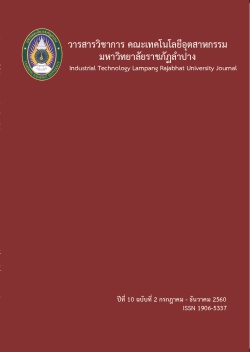การจัดเส้นทางการขนส่งน้ำดื่มโดยใช้การโปรแกรมเชิงเส้น กรณีศึกษา ห้างหุ้นส่วนจำกัด รัศมี 2015
Keywords:
การจัดเส้นทางการขนส่ง, การโปรแกรมเชิงเส้น, ธุรกิจน้ำดื่ม, OpenSolver, Vehicle routing problem, Linear programming, Drinking water businessAbstract
งานวิจัยนี้ได้ศึกษาปัญหาการจัดเส้นทางการขนส่งน้ำดื่มของห้างหุ้นส่วนจำกัด รัศมี 2015 ซึ่งเป็นวิสาหกิจขนาดเล็กทำการผลิตและจัดส่งน้ำดื่มให้กับลูกค้าแต่ละร้านเอง บริษัทยังไม่มีแผนการจัดส่งที่เหมาะสม ทำให้เกิดค่าใช้จ่ายที่เกิดจากการขนส่งมากเกินความจำเป็น ดังนั้นผู้วิจัยจึงได้ประยุกต์ใช้โปรแกรมเชิงเส้น (Linear Programming) ในการวางแผน เพื่อหาเส้นทางการจัดส่งน้ำดื่มที่สั้นที่สุด โดยคำนึงถึงปัจจัยและข้อจำกัดอื่น ๆ ที่เกี่ยวข้องด้วย หลังจากนั้นได้ใช้ OpenSolver เป็นเครื่องมือช่วยในการวิเคราะห์หาคำตอบใน Microsoft Excel ผู้วิจัยได้แบ่งการเดินรถขนส่งน้ำดื่มออกเป็น 3 กรณี ตามเส้นทางและที่ตั้งของร้านค้า ผลจากการหาระยะทางการขนส่งรวมที่สั้นที่สุดจากทั้ง 3 กรณีพบว่าการจัดเส้นทางการขนส่งน้ำดื่มโดยแบ่งเส้นทางการขนส่งออกเป็น 2 เส้นทาง มีความเหมาะสมที่สุด มีระยะทางรวมที่สั้นที่สุดเท่ากับ 72.26 กิโลเมตร และรถขนส่งสามารถบรรทุกและขนส่งน้ำดื่มได้เพียงพอในแต่ละเที่ยวที่ทำการจัดส่งได้ และเมื่อเทียบผลการจัดเส้นทางที่ได้กับการดำเนินงานในปัจจุบันพบว่ามีระยะทางที่สั้นกว่า 108.24 กิโลเมตร คิดเป็นร้อยละ 59.97 ส่งผลให้ต้นทุนค่าขนส่งลดลง 4,138.56 บาท/เดือน ทำให้สามารถจัดส่งน้ำดื่มได้รวดเร็วขึ้นและลดเวลาในการจัดส่งน้ำดื่ม
The Case Study of “Ratsamee 2015 Limited Partnership” : A Vehicle Routing Problem Solved using Linear Programming
This research studied the problem of a vehicle routing problem relating to the delivery of drinking water by a company called “Ratsamee 2015 Limited Partnership”. This company is a small business which produces and delivers drinking water to individual customers themselves. The company did not have an appropriate plan for their water delivery which resulted in their transportation costs being too high. Therefore, for this research, we applied Linear Programming to find the shortest delivery route for their drinking water by considering all the additional factors and constraints. OpenSolver was used as a tool to find the best solution in Microsoft Excel. We proposed 3 alternative solutions according to the route and location of the shop. From the results of the 3 cases, we found that dividing the transportation route into two routes was the optimal solution. The shortest overall distance was 72.26 kilometers and the vehicle could carry and deliver enough drinking water for all of the customers on each route. When compared with the current delivery results, the new distance was decreased by 108.24 kilometers, or by 59.97% and resulted in a reduction of transportation costs by 4,138.56 Baht per month. The company could deliver their product faster and also reduce delivery times.






